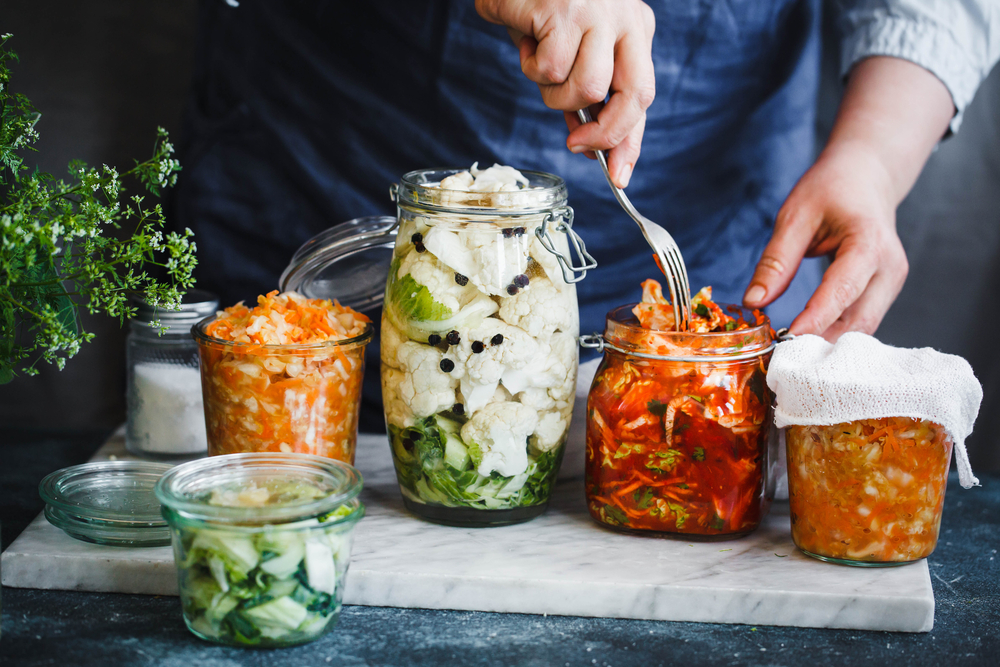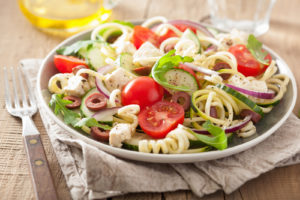
The Joy and Benefits of Fermented Foods
Fermented foods a great way to stay healthy and happy. And who doesn’t enjoy some delicious sauerkraut or spicy kim chi?
And there are so many more fermented foods to try out and see if you want to incorporate them into your diet.
What Are Fermented Foods
Fermentation is a process used to transform foods from one form to another. For example, beer and wine are fermented. And we could debate whether they’re food or not.
Some breads use fermentation like sourdough.
Another common thing to ferment is milk to produce cheese, yogurt and kefir. You can ferment tea to make kombucha.
And you can ferment vegetables.
Are They Like Pickles?
You can ferment to make a pickle, but not all pickles are fermented. Some are soaked in a brine for a short while. True fermentation should take days.
 How to Make A Quick Pickle
How to Make A Quick Pickle
To make a quick pickle, you’ll need to create a simple brine. Brines are made up of water, vinegar, sugar, salt, and seasonings. The vinegar will provide different flavors.
White vinegar (not white wine vinegar) is the classic vinegar used in making pickled cucumbers.
For foods that are stronger in flavor like carrots, you may wish to use raw apple cider vinegar for a mellower flavor on the carrot pickle.
Last night, I did a quick pickle on thinly sliced red onion. I used white vinegar, 3 bay leaves and 3 whole allspice berries. I brought the brine to a boil, and then poured it over the onions and let them sit for an hour. They were perfect on some grilled fish tacos.
You can look for brine recipes on Yummly and The Food Network.
Are They Better Than Probiotics?
In a prior blog, I talked about how probiotics are wonderful for boosting your immune system and improving your digestion.
While a lot of fermented foods have digestive benefits, not all do. For example, sourdough bread does not. Raw apple cider vinegar with the mother does. So you probably want to take a probiotic supplement in addition to adding in fermented foods.
Fermented foods offer different benefits than live bacteria like probiotic supplements. In fact not all fermented foods contain live organisms like beer and wine.
Any fermentation that removes the yeast won’t have probiotics. And since sauerkraut is often canned, it also may not have live bacteria.
So you’ll want to take a good probiotic supplement even as you increase your consumption of fermented foods like olives, balsamic vinegar, and Parmesan cheese.
Other Health Benefits of Fermented Foods
There have been studies showing the health benefits of beer and wine in moderation. Most people are familiar with wine helping with heart health as well as increasing bone density, lowering cholesterol, and reducing the risk of stroke.
But not many people are familiar with the health benefits of beer.
Beer can
- Protect your brain against Alzheimer’s
- Reduce risk of heart disease
- Lower your risk of diabetes and reduce cholesterol
- Protect against kidney stones
- Strengthen bones
As with wine, moderation is the key.

Fermented foods also help balance your stomach acid which helps prevent heartburn and aids in digestion.
Tips for Incorporating Fermented Foods
Sometimes, the intense flavor can be too much to eat the fermented food by itself. Or perhaps your body isn’t used to the healthy bacteria, and you need to ease it in.
No problem!
Try to work up from one small serving a day to two small servings. Then increase it to where you and your body are in a happy harmony
Eat Them for Breakfast
You could make a breakfast parfait with yoghurt, granola, and fruit. You could toast cheese on sourdough bread. Perhaps you enjoy natto on toast!
Are you avoiding dairy? You can make a lovely yoghurt with fermented coconut milk instead.
Use Them As Condiments
Sauerkraut, fermented salsa, kimchi add a nice punch of flavor to any meal. Add whole or sliced olives to your salads. Add chopped pickles to tuna or chicken salad.
Shred that cheese on your food. A strong cheese like Parmesano Reggiano won’t require much to add in a wonderful flavor.
If you’re fortunate enough to have heard of curtido, then you know how great it can be on tacos or salads. Curtido is a fermented cabbage, carrot, onion, hot pepper, and cucumber salad that’s served with Salvadorean fare. I like it on just about everything. And you can make curtido from other vegetables like Brussels sprouts!
Camouflage Them
Stir some sauerkraut into your stir-fried cabbage. Add it in with your eggs.
Mix some kefir with your plain yogurt. Crumble some tempeh (a fermented soybean cake) into cooked beans or grains.
If you love a smoothie, add in some fermented beets.
Turn It Into A Side
If you ferment small whole onions with carrots, green beans, and cauliflower, you then have a wonderful garnish tray to put out when entertaining. Add in a hot pepper if you want a bit of spice!
And you can mix fermented cabbage, onion, and carrots with some olive oil and fresh chopped green onions for a refreshing salad.
What If You Have A Picky Eater?
Or what if you are the picky eater. And I’d never say anyone was picky. We all have our preferred tastes.
There are some people who genetically are “supertasters” and they usually can’t stand the bitterness of brassicas like broccoli or kale. Telling them to try kale chips or broccoli tots isn’t going to work.
However, if someone is resistant because they don’t like trying new things, them look for ways to slowly introduce the fermented foods.
For example, if your PE like ice cream, have them try frozen yogurt. Yes, it doesn’t have all the health benefits, I know. However, they may find that they like the tanginess of yogurt and will be more willing to try fresh yogurt.
And most people love soup made with miso paste. It’s a clean tasting broth that you can dress up with mushrooms, green onions and tofu.
Plus it’s amazing what you can get away with in salads and smoothies.
 Where to Get Fermented Foods
Where to Get Fermented Foods
You could purchase some of these foods at your local market. You can also order items like beetroot and fennel relish from InnerOrigin. All items will be delivered to you. The link goes to InnerOrigin directly and not to a product because stock does change from time to time. And you may find something else that you’re interested in.
And you could ferment your own food. There are websites like CulturesForHealth where you can learn how to ferment foods. Unfortunately as of right now, you can’t purchase items through them. But there are plenty of other places where you can purchase item to make fermented foods like cheese, beer, and kombucha.
And for foods like sauerkraut and sourdough bread, you don’t need anything. Sauerkraut is made by thinly slicing cabbage and placing it in a brine for a few days or weeks. You could even add in shredded carrots and onions. And you could make it spicy by adding in hot peppers.
To make a sourdough starter, you can mix flour and water, and let it capture yeast from the air. There are many books on how to build up a sourdough starter. And there are courses you can watch on Craftsy or Udemy.
Plus when you make your own, you can control what you use. For example, have you ever had fermented beets with horseradish?
My Final Thoughts
Eating should be a balance of eating for fun and eating for fuel. And it’s always better when you’re eating for health and it is fun.
Food can be love. It’s a way of expressing love and joy to the people you care about.
And sometimes it’s fun to make things completely from scratch that are easy to do. Sauerkraut is just cabbage, a knife, salt, and a jar. Oh and time.
So go out and play with your food.
What do you love to make from scratch?
And what’s your most favorite fermented food?




